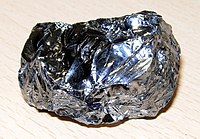
Photo from wikipedia
Coordination polymers (CPs) with bismuth(iii) as a connectivity centre have been prepared from BiX3 (X = Cl-I) and 4,4'-bipyridine (bipy) in order to implement Bi-based luminescence. The products were obtained… Click to show full abstract
Coordination polymers (CPs) with bismuth(iii) as a connectivity centre have been prepared from BiX3 (X = Cl-I) and 4,4'-bipyridine (bipy) in order to implement Bi-based luminescence. The products were obtained via different synthetic routes such as solution chemistry, melt syntheses or mechanochemical reactions. Five neutral and anionic 1D-CPs are presented that show a chemical parallel to trivalent lanthanides forming isostructural or closely related 1D-CPs, of which five additional compounds are described. Bi3+ proves to be a versatile cation for luminescence resulting from energy transfer processes between a metal and a ligand in the presented CPs. Quantum chemical calculations were carried out to investigate Bi3+-participation in the luminescence processes. The calculated results allow an assignment of the bright transitions composed of mainly metal-to-ligand-charge transfer (MLCT) character. These results show that Bi3+ can form strongly luminescent coordination compounds with N-donor ligands.
Journal Title: Dalton transactions
Year Published: 2018
Link to full text (if available)
Share on Social Media: Sign Up to like & get
recommendations!